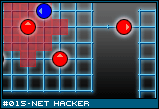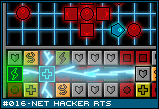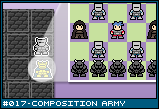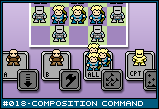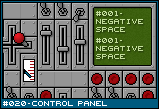| Three Hundred |
| - Index Page |
| - About... |
| - By Year |
| Collections |
| - Comp-Grid |
| - Procedural |
| - Tactics |
| - Tiny Crawl |
| - Misc |
| Previous | Mechanic #019 | Next |
The Composition Grid series is a group of gameplay mechanics that revolve around customization of one's game or abilities by placing objects at specific places on a grid. Where these objects are on the grid, as well as where they are in relation to each other, makes as much of a difference as what those objects are in the first place. Entry #018 - Composition Command made a sort of progress towards programmable combat with it's queue system. However, it was purposely designed to be simple in nature. It's purpose is to design simple special attacks, not coordinate complex maneuvers or replace the default attacking system. This entry is what happens when you do go that extra step and create a more complex programmable system for combat. I won't pretend to be the first person to create a system for programming combat. Games like Core Wars, Robot Wars, or Carnage Heart (also, I think one of the Armored Cores) all offer a system for programming one or a few robots to engage in combat for you. Carnage Heart is notable also for providing a tile-based programmable system that stood out against the other Robot Wars-like games which required actual knowledge of programming and writing scripts of code. This game is still a turn based tactical game. Unlike those other games, you do not program everything your robot thinks and does. You still decide where your unit will move, which other unit it targets for attack, and even which kind of attack it uses. This idea is closer to FFXII's Gambit System than one of those games. Instead, this entry is just a few additions to the previous idea that brings it closer to programming - namely, variables, subroutines, and conditionals.
|
![[combat1.png]](set01/img/entry019-combat1.png)
Some things to keep in mind is that each unit may only be moved once per attack. Also, units which rush to the opponent's board will disappear after their action. For instance, a knight will rush ahead up to three squares doing X damage to the first enemy unit he runs into (or, if it's enough to kill the enemy unit with Y damage, rushes ahead again for X-Y damage). Once the knight's action is over, he gracefully exits the field to allow units behind him to rush as well, or perhaps just as likely, opening up protected units to the enemy. Units that do not leave their OWN board, such as archers or wizards, do NOT disappear, thus blocking units behind them from moving forward. |
![[combat2.png]](set01/img/entry019-combat2.png)
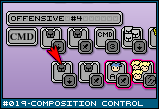
![[control1.png]](set01/img/entry019-control1.png)
![[control2.png]](set01/img/entry019-control2.png)
![[control3.png]](set01/img/entry019-control3.png)
![[control4.png]](set01/img/entry019-control4.png)
![[control5.png]](set01/img/entry019-control5.png)
![[control6.png]](set01/img/entry019-control6.png)
